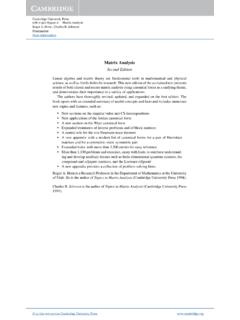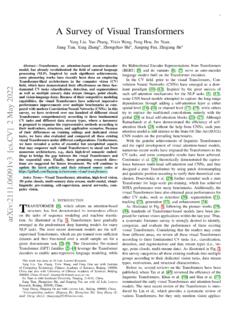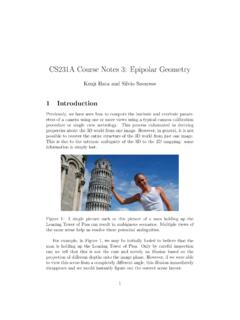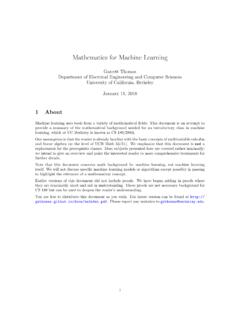Transcription of Advanced Engineering Mathematics
1 San Diego San Francisco New York BostonLondon Toronto Sydney TokyoAlan JeffreyUniversity of Newcastle-upon-TyneSponsoring EditorBarbara HollandProduction EditorJulie BolducPromotions ManagerStephanie StevensCover DesignMonty Lewis DesignText DesignThompson Steele Production ServicesFront Matter DesignPerspectivesCopyeditorKristin LandonCompositionTechBooksPrinterRR Donnelley & Sons, book is printed on acid-free paper. CopyrightC 2002 by HARCOURT/ACADEMIC PRESSAll rights part of this publication may be reproduced or transmitted in any form or by anymeans, electronic or mechanical, including photocopy, recording, or any informationstorage and retrieval system, without permission in writing from the for permission to make copies of any part of the work should be mailed to:Permissions Department, Harcourt, Inc., 6277 Sea Harbor Drive, Orlando, PressA Harcourt Science and Technology Company200 Wheeler Road, Burlington, Massachusetts 01803, PressA Harcourt Science and Technology Company525 B Street, Suite 1900, San Diego, California 92101-4495, PressHarcourt Place, 32 Jamestown Road, London NW1 7BY, of Congress Catalog Card Number: 00-108262 International Standard Book Number.
2 0-12-382592-XPRINTED IN THE UNITED STATES OF AMERICA010203040506 DOC987654321To Lisl and our familyThis Page Intentionally Left BlankCONTENTSP refacexvPART ONEREVIEW MATERIAL1 CHAPTER1 Review of Numbers, Mathematical Induction, andMathematical Complex and Argument Representation ofComplex of Complex of in One or More of Functions of One orMore Line and Tangent Plane Approximationsto and Maclaurin and Spherical Polar Coordinates and Change ofVariables in Partial Functions and the Inverse Function Theorem49viiPART TWOVECTORS AND MATRICES53 CHAPTER2 Vectors and Vector , Geometry, and Dot Product (Scalar Product) Cross Product (Vector Product) Dependence and Independence of Vectorsand Triple and the Vector Independence, Basis, and Schmidt Orthogonalization Process101 CHAPTER3 matrices and Systems of Linear Problems That Give Rise to Row Operations, Elementary matrices ,and Their Connection with Matrix Echelon and Row-Reduced EchelonForms of a and Column Spaces and Solution of Homogeneous Systemsof Linear Solution of Nonhomogeneous Systemsof Linear Inverse of a Matrix171 CHAPTER4 Eigenvalues, Eigenvectors, and Polynomial, Eigenvalues.
3 And of matrices with Complex Matrix Exponential215viiiPART THREEORDINARY DIFFERENTIAL EQUATIONS225 CHAPTER5 First Order Differential to Ordinary Differential Problems Leading to OrdinaryDifferential First Order Bernoulli Riccati and Uniqueness of Solutions264 CHAPTER6 Second and Higher Order Linear DifferentialEquations and Linear Constant Coefficient SecondOrder Linear Higher Order ConstantCoefficient Coefficients: Particular Euler of Parameters and theGreen s a Second Linearly Independent Solutionfrom a Known Solution: The Reduction of to the Standard Formu +f(x)u= of Ordinary Differential Equations:An Matrix Approach to Linear Systemsof Differential Systems of Equations351ixCHAPTER7 The Laplace Transform: Fundamental Properties of the Laplace of Equations and Applications of theLaplace Transfer Function, Control Systems, and Time Lags437 CHAPTER8 Series Solutions of Differential Equations, SpecialFunctions, and Sturm Liouville First Approach to Power Series Solutionsof Differential General Approach to Power Series Solutionsof Homogeneous Points of Linear Differential Frobenius Gamma Function Function of the First KindJn(x) Functions of the Second KindY (x) Bessel FunctionsI (x)andK (x) Critical Bending Problem: Is There a Tallest Flagpole?
4 Liouville Problems, Eigenfunctions,and Expansions and Completeness526 PART FOURFOURIER SERIES, INTEGRALS, ANDTHE FOURIER TRANSFORM543 CHAPTER9 Fourier to Fourier of Fourier Series and Their Integrationand Sine and Cosine Series on 0 x Forms of Fourier and Amplitude Spectra of a Fourier Series581xCHAPTER10 Fourier Integrals and the Fourier Fourier Fourier Cosine and Sine Transforms611 PART FIVEVECTOR CALCULUS623 CHAPTER11 Vector Differential and Vector Fields, Limits, Continuity,and of Scalar and Vector Functionsof a Single Real Derivatives and the Gradient Fields and Potential and Curl of a Curvilinear Coordinates665 CHAPTER12 Vector Integral to Vector Integral Mechanics Applications of Transport Theorems704 PART SIXCOMPLEX ANALYSIS709 CHAPTER13 Analytic Functions and , Derivatives, and Analytic Functions and Laplace s Functions, Inverse Functions,and Branches735xiCHAPTER14 Complex , the Cauchy Goursat Theorem, andContour Cauchy Integral Properties of Analytic Functions775 CHAPTER15 Laurent Series, Residues, andContour Power Series and Taylor Series and the Classificationof and the Residue of Real Integrals by Means of Residues839 CHAPTER16 The Laplace Inversion Inversion Integral for the Laplace Transform863 CHAPTER17 Conformal Mapping and Applicationsto Boundary Value Mapping and BoundaryValue Problems904 PART SEVENPARTIAL DIFFERENTIAL EQUATIONS925 CHAPTER18 Partial Differential Is a Partial Differential Equation?
5 Method of Propagation and First Order Solutions: Conservation Lawsand Three Fundamental Types of Linear Second Order and Reduction to Standard Formof a Second Order Constant Coefficient PartialDifferential Equation foru(x, y) Conditions and Initial and the One-Dimensional Wave D Alembert Solution of the Wave Equationand of General Results for the Heat and Laplace Introduction to Laplace and Fourier TransformMethods for PDEs1030 PART EIGHTNUMERICAL MATHEMATICS1043 CHAPTER19 Numerical Places and Significant of Nonlinear and Solution of Linear Systems of and Solution of Differential Equations1095 Answers1109 References1143 Index1147xiiiThis Page Intentionally Left BlankPREFACEThis book has evolved from lectures on Engineering Mathematics given regu-larly over many years to students at all levels in the United States, England, andelsewhere.
6 It covers the more Advanced aspects of Engineering Mathematics thatare common to all first Engineering degrees, and it differs from texts with similarnames by the emphasis it places on certain topics, the systematic developmentof the underlying theory before making applications, and the inclusion of newmaterial. Its special features are as opening chapter, which reviews mathematical prerequisites, serves twopurposes. The first is to refresh ideas from previous courses and to providebasic self-contained reference material. The second is to remove from the mainbody of the text certain elementary material that by tradition is usually reviewedwhen first used in the text, thereby allowing the development of more advancedideas to proceed without ExamplesThe numerous worked examples that follow the introduction of each new ideaserve in the earlier chapters to illustrate applications that require relatively littlebackground knowledge.
7 The ability to formulate physical problems in mathemat-ical terms is an essential part of all Mathematics applications. Although this is nota text on mathematical modeling, where more complicated physical applicationsare considered, the essential background is first developed to the point at whichthe physical nature of the problem becomes clear. Some examples, such as theones involving the determination of the forces acting in the struts of a framedstructure, the damping of vibrations caused by a generator and the vibrationalmodes of clamped membranes, illustrate important mathematical ideas in thecontext of practical applications. Other examples occur without specific applica-tions and their purpose is to reinforce new mathematical ideas and techniques asthey different type of example is the one that seeks to determine the heightof the tallest flagpole, where the height limitation is due to the phenomenon ofxvbuckling.
8 Although the model used does not give an accurate answer, it provides atypical example of how a mathematical model is constructed. It also illustrates thereasoning used to select a physical solution from a scenario in which other purelymathematical solutions are possible. In addition, the example demonstrates howthe choice of a unique physically meaningful solution from a set of mathematicallypossible ones can sometimes depend on physical considerations that did not enterinto the formulation of the original SetsThe need for Engineering students to have a sound understanding of mathe-matics is recognized by the systematic development of the underlying theoryand the provision of many carefully selected fully worked examples, coupled withtheir reinforcement through the provision of large sets of exercises at the endsof sections.
9 These sets, to which answers to odd-numbered exercises are listed atthe end of the book, contain many routine exercises intended to provide practicewhen dealing with the various special cases that can arise, and also more chal-lenging exercises, each of which is starred, that extend the subject matter of thetext in different many of these exercises can be solved quickly by using standardcomputer algebra packages, the author believes the fundamental mathematicalideas involved are only properly understood once a significant number of exer-cises have first been solved by hand. Computer algebra can then be used withadvantage to confirm the results, as is required in various exercise sets. Wherecomputer algebra is either required or can be used to advantage, the exercisenumbers are in blue. A comparison of computer-based solutions with those ob-tained by hand not only confirms the correctness of hand calculations, but alsoserves to illustrate how the method of solution often determines its form, andthat transforming one form of solution to another is sometimes difficult.
10 It isthe author s belief that only when fundamental ideas are fully understood is itsafe to make routine use of computer algebra, or to use a numerical packageto solve more complicated problems where the manipulation involved is pro-hibitive, or where a numerical result may be the only form of solution that MaterialTypical of some of the new material to be found in the book is the matrixexponential and its application to the solution of linear systems of ordinarydifferential equations, and the use of the Green s function. The introductory dis-cussion of the development of discontinuous solutions of first order quasilinearequations, which are essential in the study of supersonic gas flow and in vari-ous other physical applications, is also new and is not to be found account of the Laplace transform contains more detail than usual.




